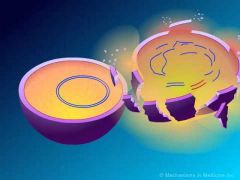![]()
![]()
![]()
Use LEFT and RIGHT arrow keys to navigate between flashcards;
Use UP and DOWN arrow keys to flip the card;
H to show hint;
A reads text to speech;
40 Cards in this Set
- Front
- Back
|
short acting b2 adrenergic agonist |
Albuterol Sulfate HFA pirbuterol metaproterenol |
|
|
Long acting b2 adrenergic agonist |
formoterol (long-acting) Foradi
salmeterol (long-acting)Serevent |
|
|
b2 adrenergic agonist + anticholinergics |
albuterol and ipratropium |
|
|
Anticholinergics |
ipratropium |
|
|
Inhaled Corticosteroids |
fluticasone (Flovent), budesonide (Pulmicort), mometasone |
|
|
β2-Adrenergic Agonists + Inhaled Corticosteroids |
formoterol +
formoterol +
salmeterol + |
|
|
Leukotriene Modifiers
reduce inflammation by inhibiting the release of proinflammatory leukotrienes, substances that are released as part of the inflammatory response. |
"-lukast" |
|
|
Mast Cell Stabilizers |
cromolyn
Cromolyn sodium is an example of a mast cell stabilizer; it makes mast cells less reactive to |
|
|
Xanthine Derivatives |
"-phylline" aminophyllineb
theophylline |
|
|
Monoclonal Antibody |
omalizumab
Omalizumab is recombinant human monoclonal antibody (anti-IgE) and is indicated for the |
|
|
Pharmacological treatment of COPD involves? |
the administration of bronchodilators, glucocorticosteroids, |
|
|
Salmeterol and formoterol should not be administered as primary therapy |
Long-acting β2-adrenergic agonists have been associated with an increased risk of severe asthma |
|
|
Adverse reactions to inhaled corticosteroids are |
primarily local and include coughing, hoarseness, |
|
|
Drugs used to treat allergic symptoms include |
antihistamines, inhaled corticosteroids and mast |
|
|
There are seven classes of antihistamines— |
ethylenediamines, ethanolamines, alkylamines, piperazines, |
|
|
Glucocorticosteroids for intranasal use include |
fluticasone (Flonase), budesonide (Rhinocort), |
|
|
Cromolyn sodium |
is a mast cell stabilizer available for intranasal and ophthalmic use. |
|
|
Antihistamines that are classified as ethanolamines |
(e.g., diphenhydramine) and phenothiazines |
|

β-Lactam antibiotics |
target the bacterial cell wall. Penicillins, cephalosporins, carbapenems, and |
|
|
There are five classes of anti-infective agents that act to inhibit bacterial protein synthesis |
aminoglycosides, macrolides, tetracyclines, amphenicols, and oxazolidinones |
|
|
Fluoroquinolones and nitroimidazoles |
are classes of anti-infectives capable of inhibiting DNA |
|
|
clindamycin |
Can cause C. difficile which is diarrhea and pseudomembranous colitis |
|
|
Metronidazole |
is the drug of choice for the treatment of C. difficile |
|
|
Tetracyclines are contraindicated in pregnancy and small children because |
they can weaken fetal |
|
|
Standard penicillins lack stability in gastric acids |
which is why most are administered intramuscularly |
|
|
Macrolides, penicillins and tetracyclines may decrease the effectiveness of oral contraceptives. |
Macrolides, penicillins and tetracyclines, use extra protection |
|
|
A common ending for macrolides |
-thromycin. |
|
|
A common ending of fluoroquinolones |
-floxacin. |
|
|
A common beginning for cephalosporins |
ceph- or cef-. |
|
|
A common beginning for sulfonamides |
sulf- |
|
|
Isoniazid special consideration |
Vitamin B6 should be taken with isoniazid |
|
|
The four major types of anxiety disorders are |
generalized anxiety disorder, panic disorder, |
|
|
The mechanism of action for most anxiolytics is |
to enhance binding of γ-aminobutyric acid |
|
|
GABA |
GABA receptor binding opens Cl− ion channels, which reduces neuronal excitability. |
|
|
antidepressants prescribed for the treatment of anxiety disorders. |
Tricyclic antidepressants, selective serotonin reuptake inhibitors, and monoamine oxidase inhibitors |
|
|
Anxiety disorder is treated by the administration of |
anxiolytics |
|
|
MAOI |
interfere with the degradation of monoamine neurotransmitters |
|
|
High-potency neuroleptics have a strong affinity for dopamine receptors. |
“Atypical” and lowpotency |
|
|
blockade of |
The greater the affinity the drug has for D2 receptors, the more effective is the drug. |
|
|
Phenothiazines |
zine* |

